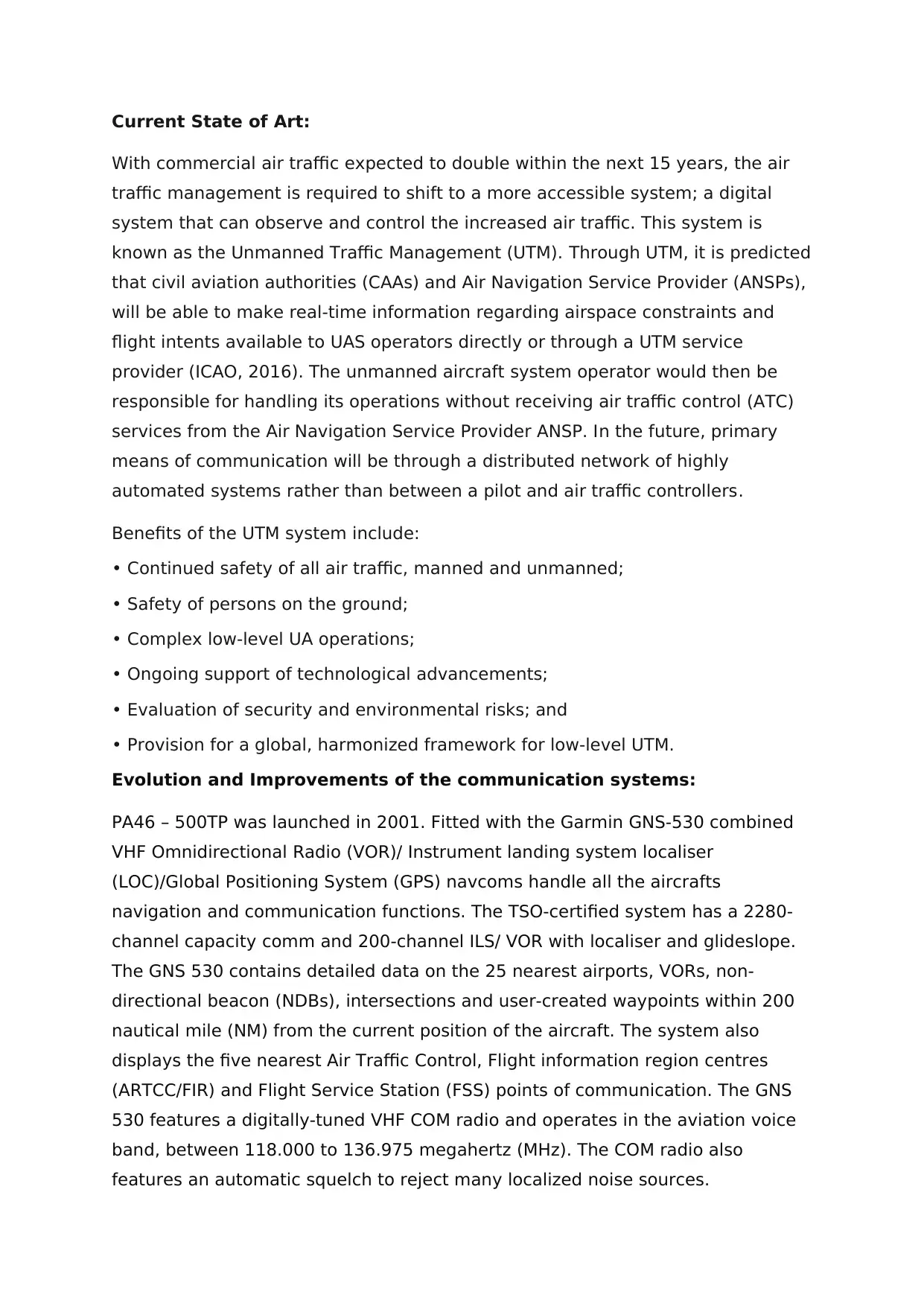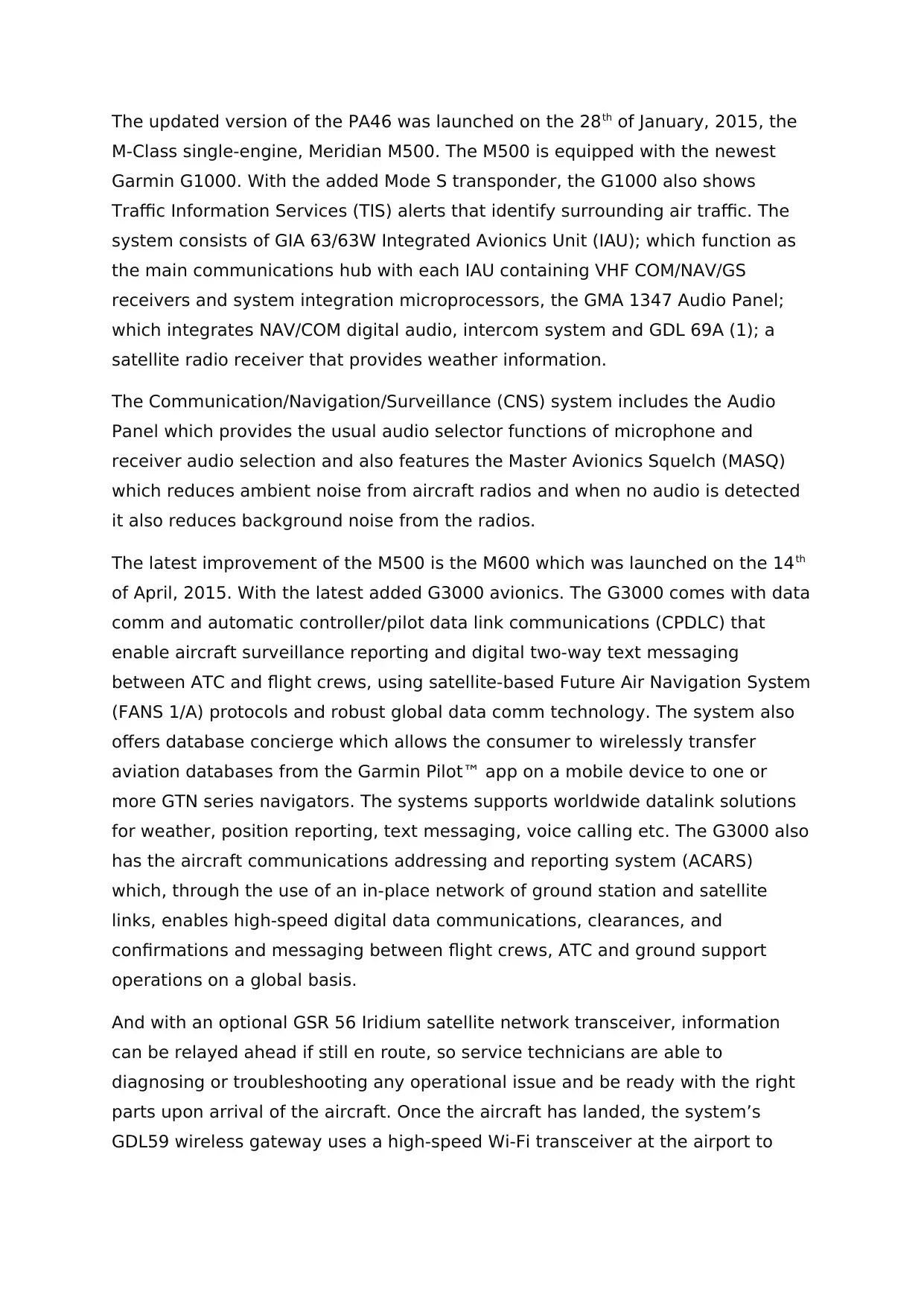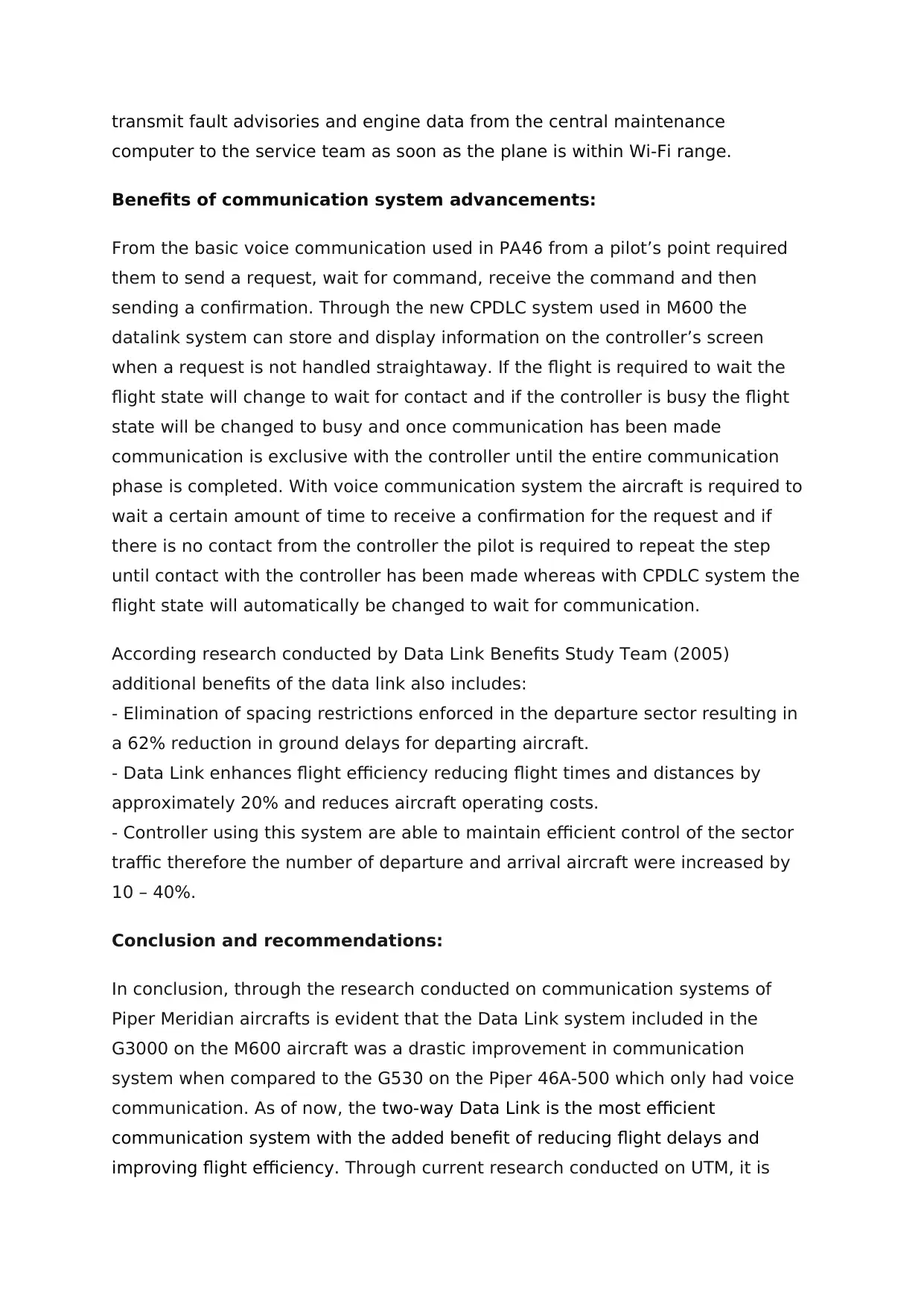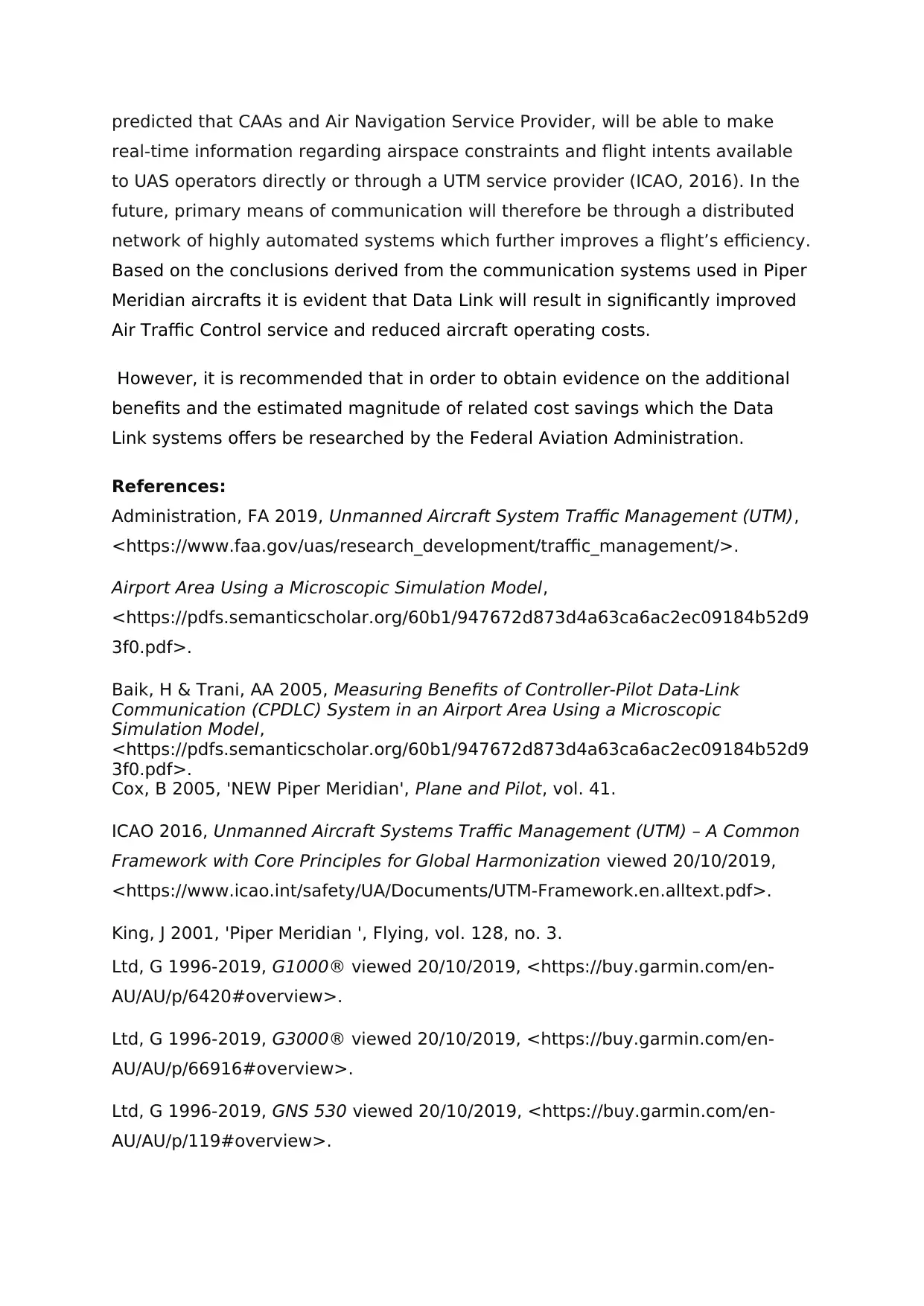Analysis of Communication Systems in Piper Meridian Aircraft Models
VerifiedAdded on 2021/04/23
|5
|1633
|60
Report
AI Summary
This report provides a comprehensive analysis of the evolution of communication systems in Piper Meridian aircraft, from the initial PA46-500TP model equipped with the Garmin GNS-530 to the later M500 and M600 models featuring the G1000 and G3000 avionics respectively. The report details the functionalities and advancements of each system, including the introduction of CPDLC (Controller-Pilot Data Link Communication) in the G3000, which facilitates digital two-way text messaging and improves flight efficiency. It highlights the benefits of data link systems, such as reduced flight delays and enhanced air traffic control, and contrasts them with the limitations of the earlier voice communication systems. The report also discusses the Unmanned Traffic Management (UTM) system and its potential impact on future air traffic management. The conclusion emphasizes the significant improvements in communication technology, particularly the shift towards data link systems, and recommends further research on the benefits of these advancements.

Current State of Art:
With commercial air traffic expected to double within the next 15 years, the air
traffic management is required to shift to a more accessible system; a digital
system that can observe and control the increased air traffic. This system is
known as the Unmanned Traffic Management (UTM). Through UTM, it is predicted
that civil aviation authorities (CAAs) and Air Navigation Service Provider (ANSPs),
will be able to make real-time information regarding airspace constraints and
flight intents available to UAS operators directly or through a UTM service
provider (ICAO, 2016). The unmanned aircraft system operator would then be
responsible for handling its operations without receiving air traffic control (ATC)
services from the Air Navigation Service Provider ANSP. In the future, primary
means of communication will be through a distributed network of highly
automated systems rather than between a pilot and air traffic controllers.
Benefits of the UTM system include:
• Continued safety of all air traffic, manned and unmanned;
• Safety of persons on the ground;
• Complex low-level UA operations;
• Ongoing support of technological advancements;
• Evaluation of security and environmental risks; and
• Provision for a global, harmonized framework for low-level UTM.
Evolution and Improvements of the communication systems:
PA46 – 500TP was launched in 2001. Fitted with the Garmin GNS-530 combined
VHF Omnidirectional Radio (VOR)/ Instrument landing system localiser
(LOC)/Global Positioning System (GPS) navcoms handle all the aircrafts
navigation and communication functions. The TSO-certified system has a 2280-
channel capacity comm and 200-channel ILS/ VOR with localiser and glideslope.
The GNS 530 contains detailed data on the 25 nearest airports, VORs, non-
directional beacon (NDBs), intersections and user-created waypoints within 200
nautical mile (NM) from the current position of the aircraft. The system also
displays the five nearest Air Traffic Control, Flight information region centres
(ARTCC/FIR) and Flight Service Station (FSS) points of communication. The GNS
530 features a digitally-tuned VHF COM radio and operates in the aviation voice
band, between 118.000 to 136.975 megahertz (MHz). The COM radio also
features an automatic squelch to reject many localized noise sources.
With commercial air traffic expected to double within the next 15 years, the air
traffic management is required to shift to a more accessible system; a digital
system that can observe and control the increased air traffic. This system is
known as the Unmanned Traffic Management (UTM). Through UTM, it is predicted
that civil aviation authorities (CAAs) and Air Navigation Service Provider (ANSPs),
will be able to make real-time information regarding airspace constraints and
flight intents available to UAS operators directly or through a UTM service
provider (ICAO, 2016). The unmanned aircraft system operator would then be
responsible for handling its operations without receiving air traffic control (ATC)
services from the Air Navigation Service Provider ANSP. In the future, primary
means of communication will be through a distributed network of highly
automated systems rather than between a pilot and air traffic controllers.
Benefits of the UTM system include:
• Continued safety of all air traffic, manned and unmanned;
• Safety of persons on the ground;
• Complex low-level UA operations;
• Ongoing support of technological advancements;
• Evaluation of security and environmental risks; and
• Provision for a global, harmonized framework for low-level UTM.
Evolution and Improvements of the communication systems:
PA46 – 500TP was launched in 2001. Fitted with the Garmin GNS-530 combined
VHF Omnidirectional Radio (VOR)/ Instrument landing system localiser
(LOC)/Global Positioning System (GPS) navcoms handle all the aircrafts
navigation and communication functions. The TSO-certified system has a 2280-
channel capacity comm and 200-channel ILS/ VOR with localiser and glideslope.
The GNS 530 contains detailed data on the 25 nearest airports, VORs, non-
directional beacon (NDBs), intersections and user-created waypoints within 200
nautical mile (NM) from the current position of the aircraft. The system also
displays the five nearest Air Traffic Control, Flight information region centres
(ARTCC/FIR) and Flight Service Station (FSS) points of communication. The GNS
530 features a digitally-tuned VHF COM radio and operates in the aviation voice
band, between 118.000 to 136.975 megahertz (MHz). The COM radio also
features an automatic squelch to reject many localized noise sources.
Paraphrase This Document
Need a fresh take? Get an instant paraphrase of this document with our AI Paraphraser

The updated version of the PA46 was launched on the 28th of January, 2015, the
M-Class single-engine, Meridian M500. The M500 is equipped with the newest
Garmin G1000. With the added Mode S transponder, the G1000 also shows
Traffic Information Services (TIS) alerts that identify surrounding air traffic. The
system consists of GIA 63/63W Integrated Avionics Unit (IAU); which function as
the main communications hub with each IAU containing VHF COM/NAV/GS
receivers and system integration microprocessors, the GMA 1347 Audio Panel;
which integrates NAV/COM digital audio, intercom system and GDL 69A (1); a
satellite radio receiver that provides weather information.
The Communication/Navigation/Surveillance (CNS) system includes the Audio
Panel which provides the usual audio selector functions of microphone and
receiver audio selection and also features the Master Avionics Squelch (MASQ)
which reduces ambient noise from aircraft radios and when no audio is detected
it also reduces background noise from the radios.
The latest improvement of the M500 is the M600 which was launched on the 14th
of April, 2015. With the latest added G3000 avionics. The G3000 comes with data
comm and automatic controller/pilot data link communications (CPDLC) that
enable aircraft surveillance reporting and digital two-way text messaging
between ATC and flight crews, using satellite-based Future Air Navigation System
(FANS 1/A) protocols and robust global data comm technology. The system also
offers database concierge which allows the consumer to wirelessly transfer
aviation databases from the Garmin Pilot™ app on a mobile device to one or
more GTN series navigators. The systems supports worldwide datalink solutions
for weather, position reporting, text messaging, voice calling etc. The G3000 also
has the aircraft communications addressing and reporting system (ACARS)
which, through the use of an in-place network of ground station and satellite
links, enables high-speed digital data communications, clearances, and
confirmations and messaging between flight crews, ATC and ground support
operations on a global basis.
And with an optional GSR 56 Iridium satellite network transceiver, information
can be relayed ahead if still en route, so service technicians are able to
diagnosing or troubleshooting any operational issue and be ready with the right
parts upon arrival of the aircraft. Once the aircraft has landed, the system’s
GDL59 wireless gateway uses a high-speed Wi-Fi transceiver at the airport to
M-Class single-engine, Meridian M500. The M500 is equipped with the newest
Garmin G1000. With the added Mode S transponder, the G1000 also shows
Traffic Information Services (TIS) alerts that identify surrounding air traffic. The
system consists of GIA 63/63W Integrated Avionics Unit (IAU); which function as
the main communications hub with each IAU containing VHF COM/NAV/GS
receivers and system integration microprocessors, the GMA 1347 Audio Panel;
which integrates NAV/COM digital audio, intercom system and GDL 69A (1); a
satellite radio receiver that provides weather information.
The Communication/Navigation/Surveillance (CNS) system includes the Audio
Panel which provides the usual audio selector functions of microphone and
receiver audio selection and also features the Master Avionics Squelch (MASQ)
which reduces ambient noise from aircraft radios and when no audio is detected
it also reduces background noise from the radios.
The latest improvement of the M500 is the M600 which was launched on the 14th
of April, 2015. With the latest added G3000 avionics. The G3000 comes with data
comm and automatic controller/pilot data link communications (CPDLC) that
enable aircraft surveillance reporting and digital two-way text messaging
between ATC and flight crews, using satellite-based Future Air Navigation System
(FANS 1/A) protocols and robust global data comm technology. The system also
offers database concierge which allows the consumer to wirelessly transfer
aviation databases from the Garmin Pilot™ app on a mobile device to one or
more GTN series navigators. The systems supports worldwide datalink solutions
for weather, position reporting, text messaging, voice calling etc. The G3000 also
has the aircraft communications addressing and reporting system (ACARS)
which, through the use of an in-place network of ground station and satellite
links, enables high-speed digital data communications, clearances, and
confirmations and messaging between flight crews, ATC and ground support
operations on a global basis.
And with an optional GSR 56 Iridium satellite network transceiver, information
can be relayed ahead if still en route, so service technicians are able to
diagnosing or troubleshooting any operational issue and be ready with the right
parts upon arrival of the aircraft. Once the aircraft has landed, the system’s
GDL59 wireless gateway uses a high-speed Wi-Fi transceiver at the airport to

transmit fault advisories and engine data from the central maintenance
computer to the service team as soon as the plane is within Wi-Fi range.
Benefits of communication system advancements:
From the basic voice communication used in PA46 from a pilot’s point required
them to send a request, wait for command, receive the command and then
sending a confirmation. Through the new CPDLC system used in M600 the
datalink system can store and display information on the controller’s screen
when a request is not handled straightaway. If the flight is required to wait the
flight state will change to wait for contact and if the controller is busy the flight
state will be changed to busy and once communication has been made
communication is exclusive with the controller until the entire communication
phase is completed. With voice communication system the aircraft is required to
wait a certain amount of time to receive a confirmation for the request and if
there is no contact from the controller the pilot is required to repeat the step
until contact with the controller has been made whereas with CPDLC system the
flight state will automatically be changed to wait for communication.
According research conducted by Data Link Benefits Study Team (2005)
additional benefits of the data link also includes:
- Elimination of spacing restrictions enforced in the departure sector resulting in
a 62% reduction in ground delays for departing aircraft.
- Data Link enhances flight efficiency reducing flight times and distances by
approximately 20% and reduces aircraft operating costs.
- Controller using this system are able to maintain efficient control of the sector
traffic therefore the number of departure and arrival aircraft were increased by
10 – 40%.
Conclusion and recommendations:
In conclusion, through the research conducted on communication systems of
Piper Meridian aircrafts is evident that the Data Link system included in the
G3000 on the M600 aircraft was a drastic improvement in communication
system when compared to the G530 on the Piper 46A-500 which only had voice
communication. As of now, the two-way Data Link is the most efficient
communication system with the added benefit of reducing flight delays and
improving flight efficiency. Through current research conducted on UTM, it is
computer to the service team as soon as the plane is within Wi-Fi range.
Benefits of communication system advancements:
From the basic voice communication used in PA46 from a pilot’s point required
them to send a request, wait for command, receive the command and then
sending a confirmation. Through the new CPDLC system used in M600 the
datalink system can store and display information on the controller’s screen
when a request is not handled straightaway. If the flight is required to wait the
flight state will change to wait for contact and if the controller is busy the flight
state will be changed to busy and once communication has been made
communication is exclusive with the controller until the entire communication
phase is completed. With voice communication system the aircraft is required to
wait a certain amount of time to receive a confirmation for the request and if
there is no contact from the controller the pilot is required to repeat the step
until contact with the controller has been made whereas with CPDLC system the
flight state will automatically be changed to wait for communication.
According research conducted by Data Link Benefits Study Team (2005)
additional benefits of the data link also includes:
- Elimination of spacing restrictions enforced in the departure sector resulting in
a 62% reduction in ground delays for departing aircraft.
- Data Link enhances flight efficiency reducing flight times and distances by
approximately 20% and reduces aircraft operating costs.
- Controller using this system are able to maintain efficient control of the sector
traffic therefore the number of departure and arrival aircraft were increased by
10 – 40%.
Conclusion and recommendations:
In conclusion, through the research conducted on communication systems of
Piper Meridian aircrafts is evident that the Data Link system included in the
G3000 on the M600 aircraft was a drastic improvement in communication
system when compared to the G530 on the Piper 46A-500 which only had voice
communication. As of now, the two-way Data Link is the most efficient
communication system with the added benefit of reducing flight delays and
improving flight efficiency. Through current research conducted on UTM, it is
⊘ This is a preview!⊘
Do you want full access?
Subscribe today to unlock all pages.

Trusted by 1+ million students worldwide

predicted that CAAs and Air Navigation Service Provider, will be able to make
real-time information regarding airspace constraints and flight intents available
to UAS operators directly or through a UTM service provider (ICAO, 2016). In the
future, primary means of communication will therefore be through a distributed
network of highly automated systems which further improves a flight’s efficiency.
Based on the conclusions derived from the communication systems used in Piper
Meridian aircrafts it is evident that Data Link will result in significantly improved
Air Traffic Control service and reduced aircraft operating costs.
However, it is recommended that in order to obtain evidence on the additional
benefits and the estimated magnitude of related cost savings which the Data
Link systems offers be researched by the Federal Aviation Administration.
References:
Administration, FA 2019, Unmanned Aircraft System Traffic Management (UTM),
<https://www.faa.gov/uas/research_development/traffic_management/>.
Airport Area Using a Microscopic Simulation Model,
<https://pdfs.semanticscholar.org/60b1/947672d873d4a63ca6ac2ec09184b52d9
3f0.pdf>.
Baik, H & Trani, AA 2005, Measuring Benefits of Controller-Pilot Data-Link
Communication (CPDLC) System in an Airport Area Using a Microscopic
Simulation Model,
<https://pdfs.semanticscholar.org/60b1/947672d873d4a63ca6ac2ec09184b52d9
3f0.pdf>.
Cox, B 2005, 'NEW Piper Meridian', Plane and Pilot, vol. 41.
ICAO 2016, Unmanned Aircraft Systems Traffic Management (UTM) – A Common
Framework with Core Principles for Global Harmonization viewed 20/10/2019,
<https://www.icao.int/safety/UA/Documents/UTM-Framework.en.alltext.pdf>.
King, J 2001, 'Piper Meridian ', Flying, vol. 128, no. 3.
Ltd, G 1996-2019, G1000® viewed 20/10/2019, <https://buy.garmin.com/en-
AU/AU/p/6420#overview>.
Ltd, G 1996-2019, G3000® viewed 20/10/2019, <https://buy.garmin.com/en-
AU/AU/p/66916#overview>.
Ltd, G 1996-2019, GNS 530 viewed 20/10/2019, <https://buy.garmin.com/en-
AU/AU/p/119#overview>.
real-time information regarding airspace constraints and flight intents available
to UAS operators directly or through a UTM service provider (ICAO, 2016). In the
future, primary means of communication will therefore be through a distributed
network of highly automated systems which further improves a flight’s efficiency.
Based on the conclusions derived from the communication systems used in Piper
Meridian aircrafts it is evident that Data Link will result in significantly improved
Air Traffic Control service and reduced aircraft operating costs.
However, it is recommended that in order to obtain evidence on the additional
benefits and the estimated magnitude of related cost savings which the Data
Link systems offers be researched by the Federal Aviation Administration.
References:
Administration, FA 2019, Unmanned Aircraft System Traffic Management (UTM),
<https://www.faa.gov/uas/research_development/traffic_management/>.
Airport Area Using a Microscopic Simulation Model,
<https://pdfs.semanticscholar.org/60b1/947672d873d4a63ca6ac2ec09184b52d9
3f0.pdf>.
Baik, H & Trani, AA 2005, Measuring Benefits of Controller-Pilot Data-Link
Communication (CPDLC) System in an Airport Area Using a Microscopic
Simulation Model,
<https://pdfs.semanticscholar.org/60b1/947672d873d4a63ca6ac2ec09184b52d9
3f0.pdf>.
Cox, B 2005, 'NEW Piper Meridian', Plane and Pilot, vol. 41.
ICAO 2016, Unmanned Aircraft Systems Traffic Management (UTM) – A Common
Framework with Core Principles for Global Harmonization viewed 20/10/2019,
<https://www.icao.int/safety/UA/Documents/UTM-Framework.en.alltext.pdf>.
King, J 2001, 'Piper Meridian ', Flying, vol. 128, no. 3.
Ltd, G 1996-2019, G1000® viewed 20/10/2019, <https://buy.garmin.com/en-
AU/AU/p/6420#overview>.
Ltd, G 1996-2019, G3000® viewed 20/10/2019, <https://buy.garmin.com/en-
AU/AU/p/66916#overview>.
Ltd, G 1996-2019, GNS 530 viewed 20/10/2019, <https://buy.garmin.com/en-
AU/AU/p/119#overview>.
Paraphrase This Document
Need a fresh take? Get an instant paraphrase of this document with our AI Paraphraser

Ltd, G 2011, G1000® Integrated Flight Deck viewed 20/10/2019, <
https://static.garmincdn.com/pumac/190-00498-07_0A_Web.pdf>
Ltd, G 2016, 500W Series viewed 20/10/2019,
<https://static.garmin.com/pumac/190-00357-00_K.pdf>.
Ltd, G 2018, Garmin viewed 20/10/2019,
<https://www8.garmin.com/aviation/brochures/IFD_solutions.pdf>.
Team, DLBS 1995, User Benefits of Two-Way Data Link ATC Communications:
Aircraft Delay and Flight Efficiency in Congested En Route Airspace, Washington,
DC.
https://static.garmincdn.com/pumac/190-00498-07_0A_Web.pdf>
Ltd, G 2016, 500W Series viewed 20/10/2019,
<https://static.garmin.com/pumac/190-00357-00_K.pdf>.
Ltd, G 2018, Garmin viewed 20/10/2019,
<https://www8.garmin.com/aviation/brochures/IFD_solutions.pdf>.
Team, DLBS 1995, User Benefits of Two-Way Data Link ATC Communications:
Aircraft Delay and Flight Efficiency in Congested En Route Airspace, Washington,
DC.
1 out of 5
Your All-in-One AI-Powered Toolkit for Academic Success.
+13062052269
info@desklib.com
Available 24*7 on WhatsApp / Email
![[object Object]](/_next/static/media/star-bottom.7253800d.svg)
Unlock your academic potential
Copyright © 2020–2025 A2Z Services. All Rights Reserved. Developed and managed by ZUCOL.